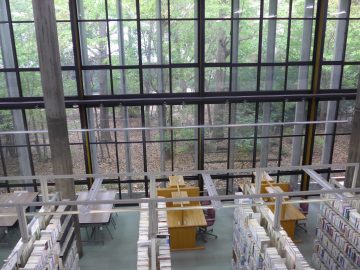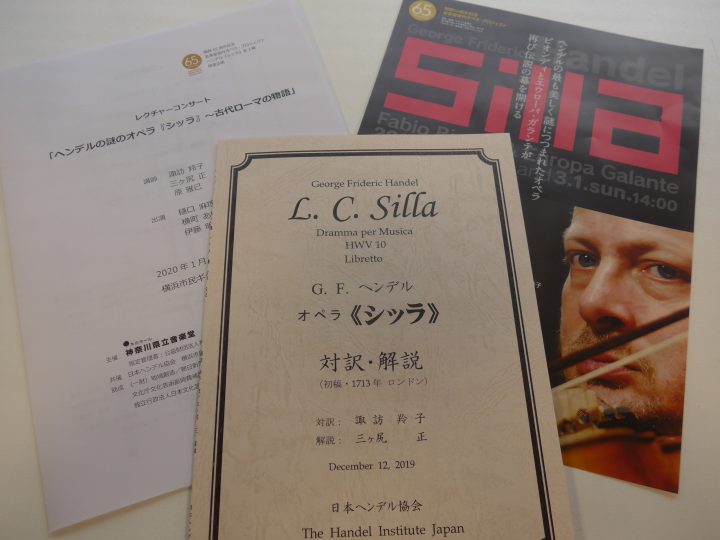EAT&ART TARO goes! "Things related to eating" exhibition ~ Includes retro food recipes made by TARO ~
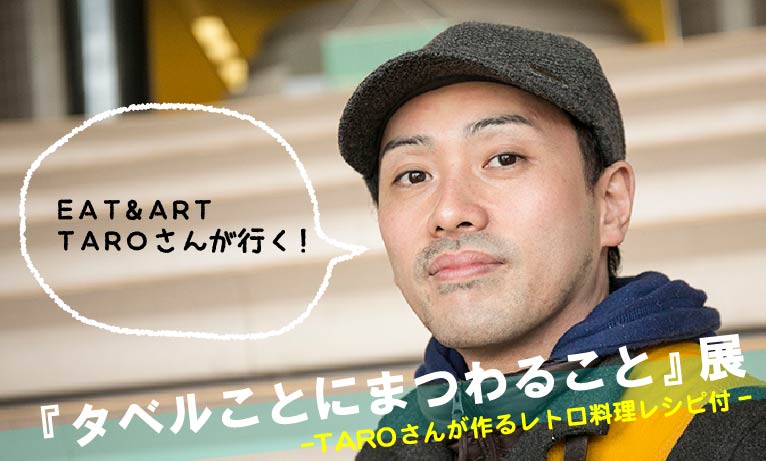
Interview & Text: Akiko Inoue Photo: Masamasa Nishino In cooperation with: Kawasaki City Museum
Kawasaki City Museum, located in Nakahara Ward, Kawasaki City, houses a wide range of works including photography, graphics, manga, fine arts and video, and presents a variety of exhibits. The permanent exhibition currently being held is titled "Things Related to Eating," which focuses on the act of "eating," which is essential to our lives. This time, we welcomed EAT&ART TARO, who is developing an art project with an interesting concept based on the theme of "food," as our guest, and together we toured the exhibition rooms, which are divided into seven themes. In the last exhibition room, we found a corner featuring one of TARO's works, "Retro Cooking."
This time, TARO has kindly given us a special retro cooking session. The menu is "Spaghetti Milano" from "Restaurant Pony" which was a real restaurant in Bashamichi, Yokohama (established in 1955, closed in 2012). Check out page 2 for the recipe.
Now, let's get started by taking a look around the exhibition hall with TARO.
The first theme , "Arawas Koto," features works with food as a motif. The most innovative of these is Ippei Okamoto's "Street Killer" (1916). A passerby eating a watermelon is slashed in the stomach with a sword, and the cross section of the slashed stomach is also a watermelon.
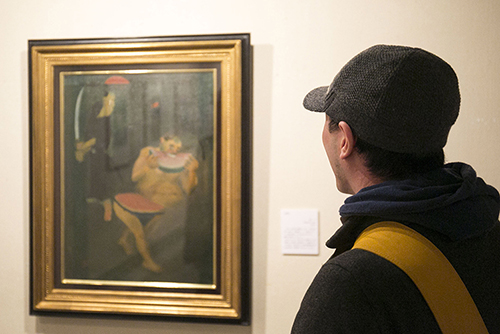
Interviewer (omitted): Why watermelon?
TARO (hereinafter T) : I wonder why...but shouldn't you want to cut it into sections first?
I was cutting a watermelon and I wondered if it would look like this if I cut open its belly... (laughs)
The setting sun in the background is definitely a reference to watermelon.![]()
The next theme , "Iwau Koto," featured works related to food at various annual events. As with the previous one, Ippei Okamoto's "Humor Karuta" was a card game filled with humor from that time, as its name suggests.
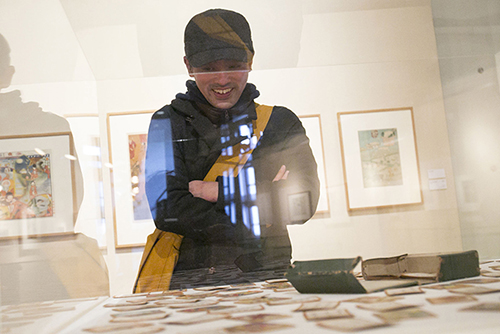
T : (Looking at the cards, thinking deeply...) "Is there a belly button in the anpan...?"
-The belly button is that thing in the middle that looks like a perilla plant.
T : Kimuraya's anpan (sweet bean buns) are made with salted cherry blossoms.
I was a bit curious, so I did some research on the "navel" of anpan. Apparently it was originally added as a gift to Emperor Meiji to differentiate it from other anpan. If you're interested, please click here .
By the way, the "na" in this "Humor Karuta" was "Napoleon Shimanagashi." The words chosen were so interesting and surprising that you'll be surprised, even though they are cards that children play with! Please come and see them at the venue.![]()
The next theme , "Tsunagelkoto," featured photographs of Japanese rural areas before the 1960s. "Today, when you go to a market, you see cardboard boxes piled up like huge buildings, but back then there were no such things, so they used straw to pack things," said TARO. Sonobe Kiyoshi's "Shipping Cabbages" (1957) shows a man taking a break in a field where cabbages wrapped in straw are piled up. The things they make are the same now as they were back then, but the scenery is changing. I was able to sense a big history from just one small page of people's lives.![]()
In the next section, "Yutaka ni Naru Koto," you can see many advertisements from the 1980s in Japan. The 1980s was a time of rapid economic growth, and people's lives began to change dramatically. As if reflecting the era of mass production and mass consumption, advertising was also showing signs of momentum.

T: "The bright red food on the bright red plate is amazing. The way the steam rises also feels a bit over the top."
- "Oh, China is sinking in."... The catchphrase is also excellent. Kibun's copy is "The Waist Size Story" (laughs)
T : It seems like Kibun is going for a diet-oriented approach these days. It says to stop jogging and eat steaks, and to grill fishcakes with margarine instead (laughs).
The display of posters with advertising expressions reminiscent of the era was full of interesting things to poke fun at, but the corner where old commercials were screened by company and era using nostalgic cathode ray tube televisions was also interesting. I'm sure it will bring back nostalgia for people of a certain generation, and a sense of freshness for those of later generations.
![]()
Next, in the same room, across the wall, were works on the theme of "Things we can't eat," which contrasted with the vivid food images seen in the advertisements. By deliberately arranging contrasting themes in the same exhibition room, the exhibition appealed to the viewer whether they liked it or not. In front of a photo showing famine in Africa, TARO muttered, "This is the 1980s, the same era as the advertisement." This startled me.
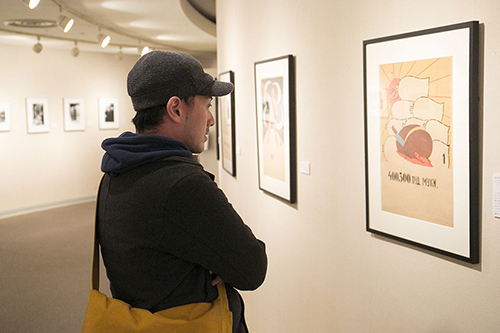
![]()
Following "Things that make you feel good," which was themed on the places surrounding food, a semi-nude photograph of Mariko Kaga was also exhibited in "Things that make you feel good," which is an image of a woman depicted in a work. Some may wonder if it has anything to do with food, but in the background of Yoshihiro Tachiki's photograph titled "Private Life Mariko Kaga," there is a kitchen. Mariko Kaga is beautiful, as always!
Next up we move on to TARO's "Retro Cooking" corner.
On the wall leading to TARO's room, there are some beautiful women... They are the same women who grace the covers of retro cookbooks.
■ What is Retro Cooking? ■
The 1950s and 60s were the era when cooking shows on television and numerous cooking magazines appeared. This art project by EAT&ART TARO aims to preserve and collect cookbooks from that time, and to hold events where people actually recreate and cook the recipes in those books. Through this, they can discover the tastes and food culture of that time.
![]()
As we walk along the wall, admiring the retro cookbook covers arranged in chronological order, we arrive at TARO's room. "I love collecting cookbooks from the Showa era," says TARO. Selected from his precious collection, the covers of "Bessatsu Shufu no Tomo" magazine from 1931 to 1965 are arranged in chronological order. It's interesting to see the differences when they're arranged like this. Magazine covers can be a resource for understanding the era. It's especially interesting that cookbooks give us a glimpse into the household circumstances of the time.
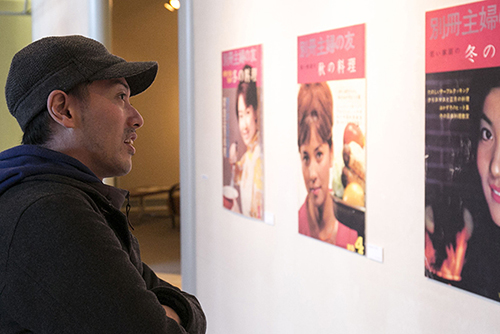
T: By 1955, the dishes featured on the cover had started to focus on meat, and the way food was presented had changed from small portions to large platters.
-People here have already started making sweets with fresh cream.
T : It says "Prize Contest Mixer" on the cover (laughs).
As we walked into the room listening to TARO's explanation, we found a large selection of retro cookbooks lined up, carefully selected from his extensive collection.
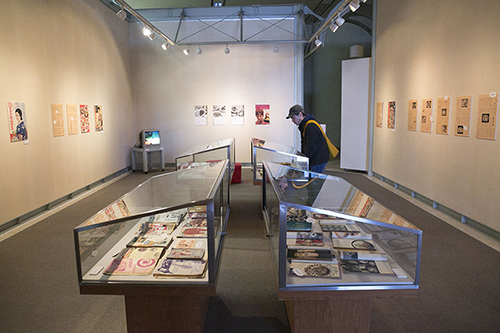
It's also interesting to see how the culinary experts of the time have made creative adaptations to the recipes so that they could be made using the equipment and ingredients available in kitchens at the time.
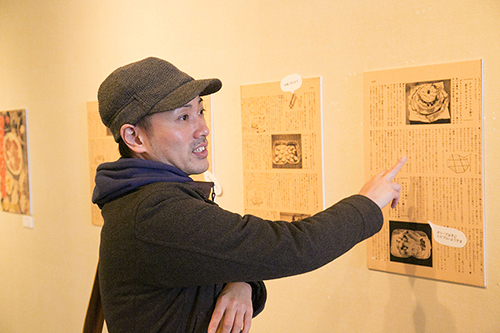
T : For example, what do you think is on top of this "decorated cake-style sandwich"?
-Normally it would be olive...
T : Yes, I actually wanted to use olives and the cooking expert knows about olives, but
Even if you write olive, no one can make it, so you have to think of a substitute. And that substitute is green plum.
-Wow !
There were also many other recipes using familiar ingredients that I wanted to try, such as an (innovative) way of making coffee from the early Showa period, and a recipe for decorative eggs that resembled rabbits and apples, so it was an exhibition that made me want to not just look but actually try making the dishes.![]()
Well, this is a must-see for those who are practical!
This is the retro cooking corner where the "Restaurant Pony" mentioned at the beginning appears. In the exhibition room, there was a noodle recipe that the owner of Pony provided to a magazine at the time, and a video of TARO making it.
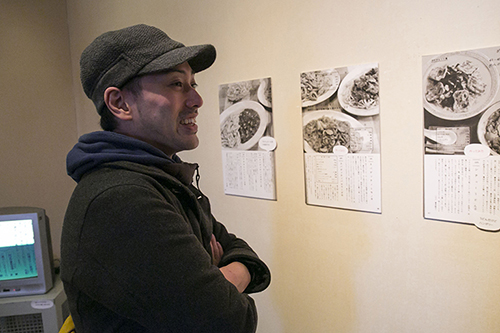
- "Ham Soba" is a great name for a menu item.
T : We also have "stew udon" here (laughs).
This "Spaghetti Balois" is spaghetti with beef mince and liver.
It's a sauce based on Hayashirou, but it's called Neapolitan sauce.
-Did Neapolitan mean Hayashi sauce back then?
T : Nowadays, ketchup-flavored Neapolitan is quite common, but
I think that if we had made even a slight mistake, the dissolved Hayashirou might have ended up becoming Neapolitan pasta.
Indeed, according to TARO, Western food started to spread to ordinary households around the 1950s, and since then, various cooking experts have developed various recipes. However, unfortunately, many recipes never caught on and have disappeared, and this "Spaghetti Balois" may be one of them. However, it cannot be denied that there is a possibility that some grandmother somewhere is still making it, and if so, it can be said to be a respectable food culture. TARO said that it is very interesting to see such things by getting involved with retro cookbooks.
![]()
Similarly, Restaurant Pony's retro recipes include a menu item called "Spaghetti Milano."
Here is the retro recipe! This was actually made by TARO for MAGCUL.NET. The original recipe is from the 1963 issue of "Bessatsu Shufu no Tomo: Autumn Cooking for Young Families."
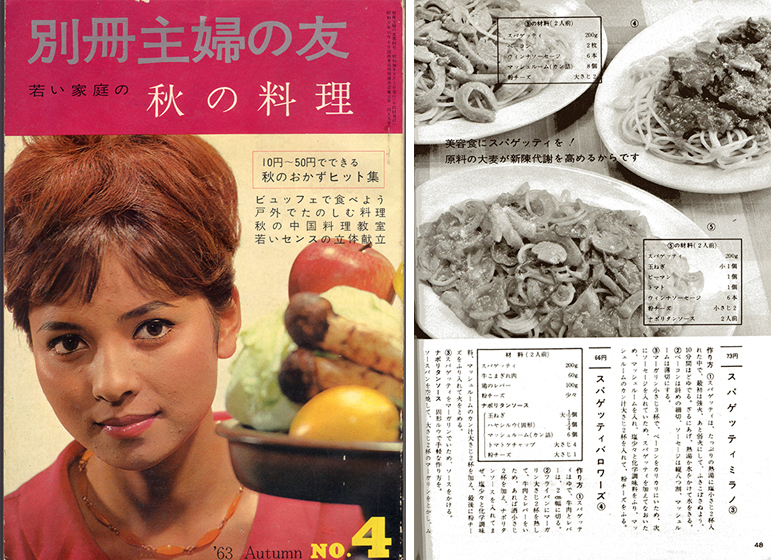
[How to make]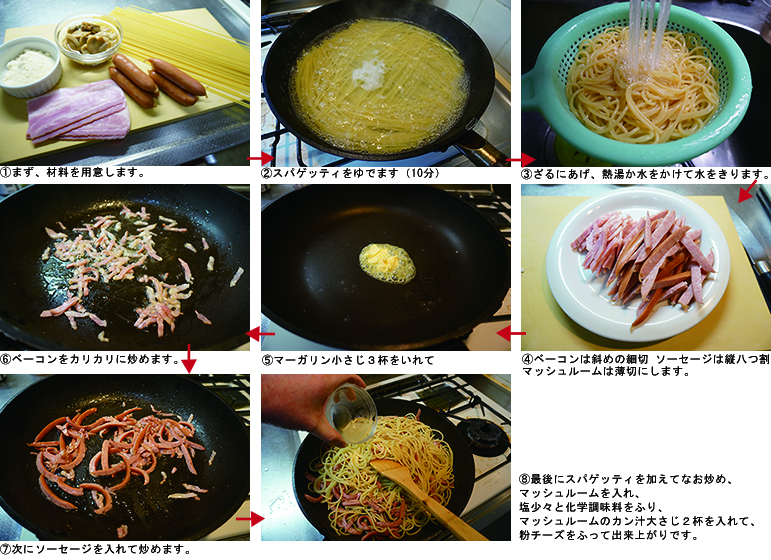
By the way, here's the finished photo!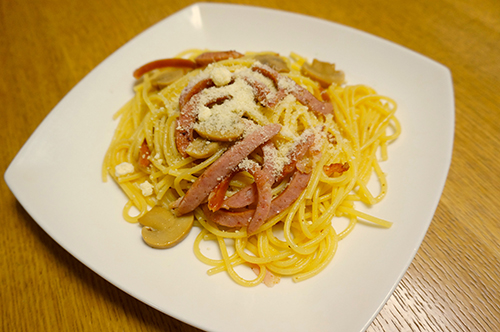
T : This one uses bacon and sausage.
-There are no vegetables in it at all.
T : Right. I did a little research and found that there is a trend to call meaty dishes Milanese style.
I'm starting to understand, but even today in some regions, Milanese style means "ankake" (thickened sauce),
In some places, the soy sauce flavor is called Milanese style, and I don't understand it anymore (lol)
During the chaotic postwar period, Italian restaurants would randomly assign the names of cities to dishes, and this has left a legacy of various Milanese dishes in various regions. Meanwhile, perhaps thanks to the Hotel New Grand, the ketchup-flavored sauce for Neapolitan has become popular throughout the country. Of course, it's well-known that Neapolitan doesn't actually exist in Naples. One thing I learned through this exhibition is that the power of corporations plays a major role in the spread of food culture. I was deeply impressed by how the dishes we eat today are the result of someone's recipes, which have been passed down in some way and changed shape to become what they are today. At the same time, I became interested in lost recipes that I have never tried.![]()
This time, I went around the "Taberukoto no Tsuwaru" exhibition with TARO and was able to notice the depth of the very familiar act of "eating". Also, through the retro cookbook, I was interested in "how food culture spreads", something I had never really thought about before. If you dig deeper according to your interests, you will be able to see the lives of people at that time. And you will realize that those lives were full of wisdom and playfulness.
If you want to know more about retro cooking, please come to TARO's workshop on Saturday, February 8th at the same venue. You may discover things that were not included here, or discover things that no one else has noticed by actually interacting with the works.
■ Event Information ■
Related events for the "Taberukoto-related things" exhibition
"Things related to making things - A roundtable discussion on recipes"
Date and time: 2.8 (Sat) 14:00-16:00
Venue: Kawasaki City Museum Art Gallery
Lecturer: EAT&ART TARO
Participation Fee: 300 yen
Application: If you apply by fax or email, please state the name, number of participants, address, phone number, and fax number (if applying by fax) and send it to the "Taberukoto no Tsuwaru Koto Workshop" staff. Fax: 044-754-4533 Email: 25museum@city.kawasaki.jp
